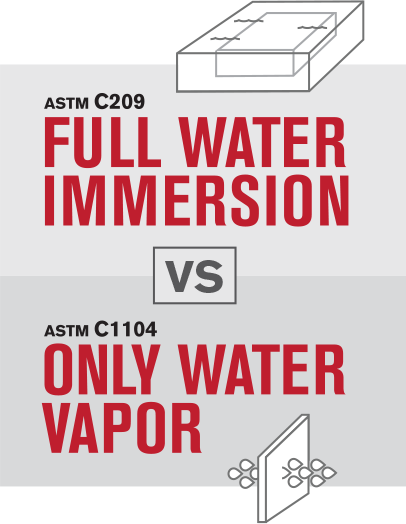
A Deep Dive Into Polyiso and Mineral Wool Exterior Wall Continuous Insulation (CI)
Based on the white paper, Mineral Wool and Polyisocyanurate Insulation: A Comparative Study of Water Absorption, Drying and Rewetting by M. Steven Doggett, Ph.D, Principal Scientist, Built Environments, Inc. View infographic
Mineral Wool Wall CI Absorption & Drying*
WHEN TESTED FOR WATER ABSORPTION (ASTM C209) IT WAS FOUND THAT:
- Mineral wool wall CI absorbs 18% to 78% of its weight in water.
- Mineral wool wall CI takes 3 to 7 days to dry.
ASTM C209 is the standard sorption test for closed pore foam insulation. This test requires insulation samples be immersed in one inch of standing water for a period of two hours.
Mineral wool wall CI absorbs 18–78% of its weight in water when wetted with liquid water because it is an open pore, fibrous material. Sorption potentials for mineral wool wall CI have, in the past, been evaluated utilizing water vapor via ASTM C1104 (95 ±3% RH). That makes the product appear to perform better than it really does because it doesn’t measure bulk water. Sorption potentials for mineral wool wall CI have therefore been underestimated.
For example, it has always been assumed that water freely drains from the void structure and that water retained by mineral wool wall CI dries quickly due to its inherently high vapor permeance. Based on this study, neither is true. Instead, water is suspended by capillary forces and the network of fibers.
*Based on the white paper, Mineral Wool and Polyisocyanurate Insulation: A Comparative Study of Water Absorption, Drying and Rewetting by M. Steven Doggett, Ph.D, Principal Scientist, Built Environments, Inc.
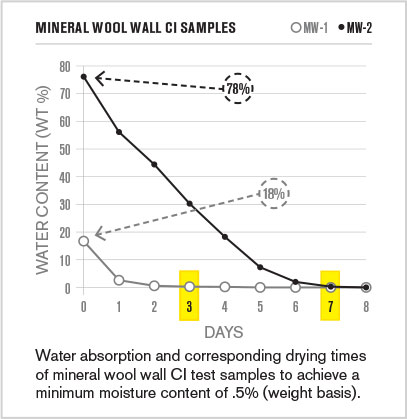
Drastic Performance Variations in Mineral Wool Wall CI Products*
When tested for water absorption (ASTM C209):
It was found that two different brands of mineral wool wall CI product, with similar declarations for densities and binder type, had large differences in water absorption rates.
This indicates other factors that can’t be identified visually. Factors may include the raw materials used to make the fibers, chemicals used to bind the mineral fibers together, additives to increase water repellency, the direction of the fibers and how much the fibers are compressed during manufacturing.
Even within mineral wool wall CI product bundles from the same company, the range of sorption values varied significantly between individual pieces.
A lack of sorption consistency in mineral wool wall CI products creates a wider variation in drying times, which is why tests showed a range of 3–7 days to achieve the same endpoint of 0.5% water content.
*Based on the white paper, Mineral Wool and Polyisocyanurate Insulation: A Comparative Study of Water Absorption, Drying and Rewetting by M. Steven Doggett, Ph.D, Principal Scientist, Built Environments, Inc.
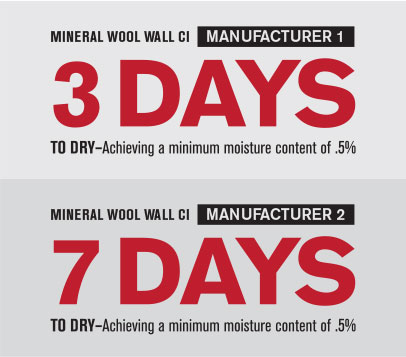
Rewetting: Mineral Wool Wall CI’s Absorption & Holding Capacities*
When mineral wool wall CI was tested in accordance with ASTM C209 and then rewetted, it was found that:
-
Rewetting mineral wool wall CI increased water absorption by 130–190% and extended dry times by up to 4 days.
- Repeated wetting of mineral wool wall CI revealed moisture holding capacities that vary due to changing pore and fiber structure.
Rewetting tests conducted on mineral wool wall CI specimens revealed a substantial increase in water absorption. This is significant, as results from standard sorption testing don’t account for prior exposure to water. Even a single previous exposure to liquid water may result in increased sorption.
When rewet over seven cycles, separation of fiber layers and notable physical voids became obvious. These changes caused the product to absorb and drain differently than it had during the previous cycle, implying physical product changes are the main cause of greater water absorption upon rewetting.

*Based on the white paper, Mineral Wool and Polyisocyanurate Insulation: A Comparative Study of Water Absorption, Drying and Rewetting by M. Steven Doggett, Ph.D, Principal Scientist, Built Environments, Inc.
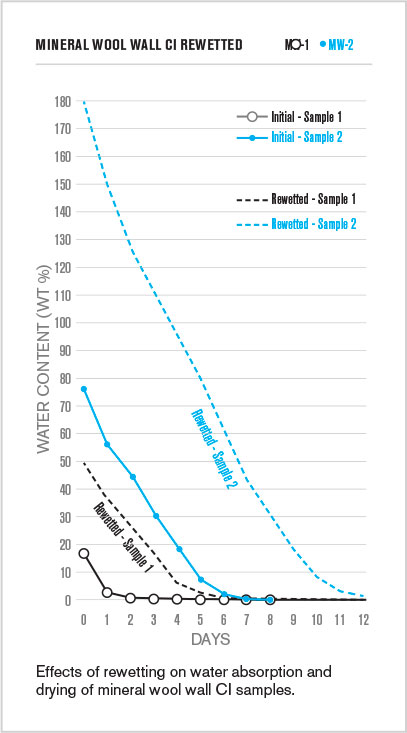
Polyiso Absorption and Drying Results*
When tested in accordance with ASTM C209, it was found that:
-
Foil Faced and Coated Glass Faced Polyiso absorbed less than 4% water by weight and less than 0.13% by volume.
-
Both polyiso products were effectively dry within 24 hours.
Specimens of foil faced and coated-glass faced polyiso were immersed in one inch of standing water for two hours. Specimens were drained in accordance with standard protocols.
Fast drying times for the two polyisocyanurate samples were attributed to low water absorption coupled with the ability to rapidly release water vapor.
When rewet, the polyiso specimens showed no appreciable increase in water absorption – and no significant changes in drying time. Polyiso sorption behaviors and dry times remained constant because the structure of polyiso is unaltered by wetting and rewetting.
Rewetting resulted in no changes to the drying time for polyiso.
*Based on the white paper, Mineral Wool and Polyisocyanurate Insulation: A Comparative Study of Water Absorption, Drying and Rewetting by M. Steven Doggett, Ph.D, Principal Scientist, Built Environments, Inc.
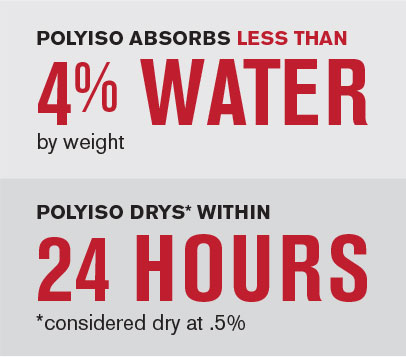
Mineral Wool Wall CI Absorbs More Water Than Polyiso*
When tested in accordance with ASTM C209, it was found that:
-
Mineral wool wall CI absorbs 8–38 times more water than foil faced polyiso.
-
Drying requires 2–6 days longer for mineral wool wall CI than polyiso.
These test findings show that water absorption is directly linked to pore structure. Open, fibrous materials like mineral wool wall CI absorb and retain significantly more water than closed-cell foam. The testing even allows for specimens to drain for 10 minutes prior to initial weighing, but mineral wool wall CI still absorbs a minimum of 8–38 times more water than foil faced polyiso.
Previously, it was assumed that water drains freely and retained water dries quickly due to the structure and high vapor permeance of mineral wool wall CI. Testing in accordance with ASTM C209 shows neither is true of mineral wool wall CI. It takes 2–6 days longer to dry than polyiso.
These findings also indicate corresponding effects on insulation. Reductions in claimed R-values are expected, as even partial wetting negates thermal performance.
*Based on the white paper, Mineral Wool and Polyisocyanurate Insulation: A Comparative Study of Water Absorption, Drying and Rewetting by M. Steven Doggett, Ph.D, Principal Scientist, Built Environments, Inc.
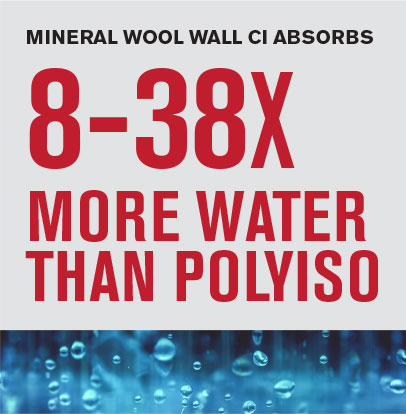
Testing Standards*
To equally compare mineral wool wall CI and polyiso, use the same test.
Mineral wool wall CI and polyiso have used vastly different test methods in the past, despite being considered for the same function within the building envelope.
When compared using the same test standards (ASTM C209), the water resistive characteristics of polyiso and mineral wool wall CI can be more accurately compared.
Standard testing for mineral wool wall CI (ASTM C1104) exposes tests specimens to water vapor. When both polyiso and mineral wool wall CI are tested using liquid water, significant differences can be observed. Mineral wool wall CI’s test methodologies have been based on the need to demonstrate low water absorption to achieve the perception of quality performance.
Sorption potentials for mineral wool wall CI have been underestimated, as shown by recent studies involving both partial and full immersion. Even partial wetting negates the insulating performance of mineral wool wall CI.
Polyiso, on the other hand, has low absorption potential and high drying potential.
*Based on the white paper, Mineral Wool and Polyisocyanurate Insulation: A Comparative Study of Water Absorption, Drying and Rewetting by M. Steven Doggett, Ph.D, Principal Scientist, Built Environments, Inc.
